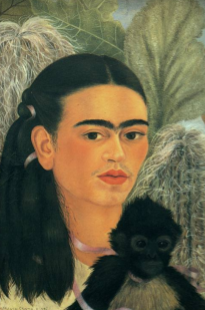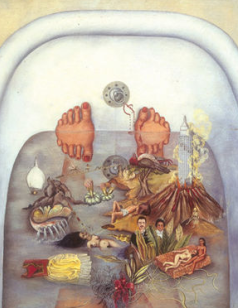Women’s History Month: Frida Kahlo
More stories from Jane Taylor

Self portrait

Frida Kahlo, born in Coyoacán, Mexico, on July 6, 1907, was a Mexican surrealist painter that redefined art, but also served as a major feminist icon. Known best for her infamous unibrow, her at the time provocatively sexual nature, and her participation in the communist party, her radical views furthermore served as a lodestar, inspiring others to live their lives openly without fear of the social norm. Frida Kahlo is remembered for her unparalleled courage and her defiance of traditional boundaries not only for women but for people everywhere.
From an early age she faced illness as she acquired Polio at the age of six, leaving her right leg severely disfigured, and later at the age of 18 was involved in a serious bus accident, leaving her bedridden for months with long term injuries that would plague her for the rest of her life, particularly her inability to bear children (Herrera). While bedridden she used a mirror above her bed to paint self-portraits, and from her incapacitated state grew some of her earliest inspirations in her works of art (ABC-CLIO). She married famous surrealist artists Diego Rivera, and although they would have a tense marriage he fostered her love for art and supported her visions. Through this marriage she would become pregnant three times, only through need to terminate all of them, and this infertility was translated in many of her works. Following her marriage, her artistic career blossomed and she produced an estimated 143 paintings in her lifetime (“Frida Kahlo Biography”) . Later in life, her health began to rapidly decline and as surgeries increased she turned further to alcohol and painkillers to ease the physical and emotional pain that her life had given her. On July 13th of 1954 seriously ill with pneumonia she died in her home in Mexico, although the cause of death is debated as many believe it was suicide (Herrera). Her last diary entry reflects deeply her attitude and the artistic beauty that she is remembered for, reading, “I hope the exit is joyful – and I hope never to return”.
A major icon for feminists today is Frida’s infamous brow and body hair. At a time when Western culture endorsed hair removal on women, Frida refused and maintained her natural state. She did not alter her body in any way and did so in a direct attempt to defy the social norm and make a statement in opposition of it. At present times, women across the world are undergoing a similar revolution of body hair, and Frida’s brow is at the forefront, as more and more women are choosing to forego hair removal and embrace their natural beauty. Frida has and will continue to inspire others to do the same, and in this way she remains immortal
Beyond her physical appearance she is also noted for her religious resistance. The Mexican culture is prominently Roman Catholic, however Frida was openly atheist and opposed traditional religious views. Although she embraced spirituality, as is seen in many of her paintings such as her work Moses, she did not embrace the traditional religious views, staying true to her uniquely rebellious spirit. She also was an open supporter of the Communist Party, as a member of the Mexican Communist Party. She even gave asylum to Leon Trotsky in 1937 and had a brief affair with him, supporting another large part of her personality and views, which was her sexual liberation (Herrera).
Frida had many sexual partners throughout her lifetime, most out of wedlock. She truly defied societal expectations, which at the time prized a woman based on the condition of her virginity. She instead refused to listen, and embraced a sexual appetite that was accustomed only to men at the time. She was openly bisexual, and one of her most famous relationships was with Josephine Baker (“Frida Kahlo Biography”). She also frequently dressed in men’s clothing and did not hold to traditional gender stereotypes, embracing her masculinity. She also frequently painted herself in the nude and revealed not only her physical but also emotional fragility.
Frida Kahlo is also remembered for her lifelong struggle with physical and mental illnesses. From a young age she was crippled and her physical health only worsened with age. She was barren as a result of a bus accident at the age of 18 and struggled with this with three terminated pregnancies in her lifetime. This would be the cause of her young death but also what drove much of her depression and her later dependency on drugs and alcohol (“Frida Kahlo Biography”). Although infertile, she unknowingly gave birth to a new age of social liberation.
Today, we choose to honor and remember Frida Kahlo as a revolutionary female figure whose courage and legacy transcend time and inspire others to do the same. Ahead of her time in sexual and gender freedom, the redefining of beauty standards, artistic expression, and political ferocity, she serves as a guide whose message we must all look to with idealism and hope, as she shows us to remain fearless through whatever endeavours may come, and to always stand up for what we believe in no matter the opposition.
In times of trouble, we look to Frida and ask ourselves as she did, “feet, what do I need you for when I have wings to fly?”
Works Cited
“Frida Kahlo Biography.” Frida Kahlo Biography. N.p., n.d. Web. 21 Feb. 2017.
“Frida Kahlo.” World History: The Modern Era, ABC-CLIO, 2017. 20 Feb. 2017.
Hayden Herrera. “Kahlo, Frida.” Grove Art Online. Oxford Art Online. Oxford University Press. Web. 21 Feb. 2017.